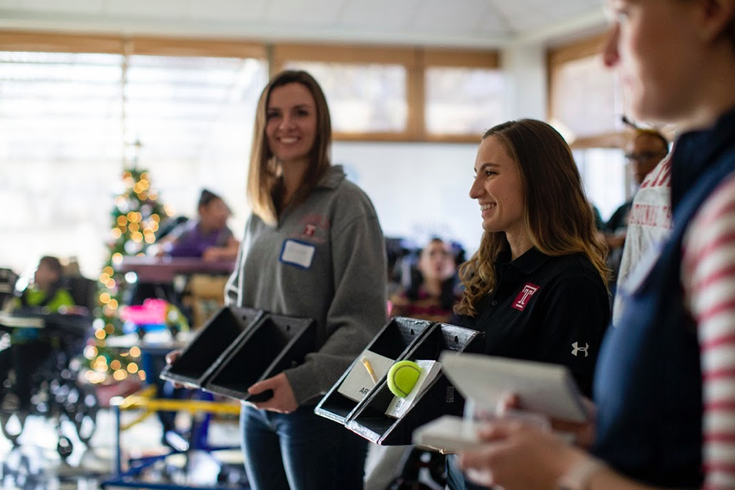
December 12, 2018
 Ryan S. Brandenberg/Temple University Photography
Ryan S. Brandenberg/Temple University Photography
Temple University students explain the decision boxes they created for students at HMS School for Children with Cerebral Palsy. Students with cognitive disabilities benefit in decision-making from having overt choices, like choosing between art class (displayed through a paint brush) or receiving OT treatment (displayed through a tennis ball).
A group of Temple University students made a special delivery at Philadelphia's HMS School for Children with Cerebral Palsy on Wednesday.
The Temple students – part of Temple's occupational therapy program – brought a series of customized fittings designed to help 30 children with mobility-related disorders better participate in social activities and complete routine tasks.
The adaptive fittings featured a variety of devices, including trays and visors made to fit on wheelchairs and stackable leg rests, which allow the children to more easily stretch their legs.
The devices were designed with specific students in mind. Earlier this year, the Temple students met with the HMS students to assess their individual needs. They then designed, built and decorated the customized devices with the assistance of Temple art and architecture students.
A teenage boy, who enjoys delivering mail to teachers and classmates, received a mailbox that attaches to his mobilized wheelchair. Another student, who has a fondness for playing the keyboard, received a tray that allowed the instrument to be placed on a wheelchair without risk of falling.
Emily Manchick, a master's student in Temple's occupational therapy program, helped created a functioning wheel that helps students select their partners for group activities.
"We weren't sure how we would pull it off, but after meeting and consulting with the students, we can see how important this device will be to their large assemblies and classwork," Manchick said.
Other students created decision boxes, which help students with cognitive disabilities choose between activities, such as art class or receiving occupational therapy treatments.
Most of the devices are made of a lightweight – but durable – three-ply cardboard, which improves portability and reduces production costs.
Last year, Temple students produced seven adaptive fittings for the HMS students. This year, they upgraded those fittings in addition to producing several new fittings.
"These young people can outgrow their adaptive fittings in a short period of time," said Rochelle Mendonca, associate professor of occupational therapy. "The use of this material allows us to expand the reach of our program and impact the lives of more students through this assistive technology."
Follow John & PhillyVoice on Twitter: @WriterJohnKopp | @thePhillyVoice
Like us on Facebook: PhillyVoice
Add John's RSS feed to your feed reader
Have a news tip? Let us know.